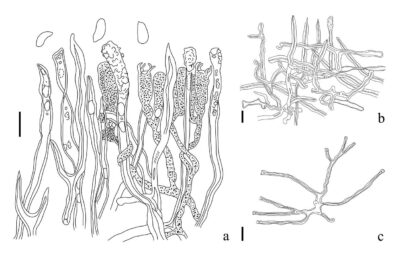Fungalpedia – Note 380, Cellulariella
Cellulariella Zmitr. & Malysheva
Citation when using this data: Tibpromma et al. 2024 (in prep.) – Fungalpedia, Macrofungi.
Index Fungorum, Facesoffungi, MycoBank, GenBank, Fig. 1
Classification: Polyporaceae, Polyporales, Incertae sedis, Agaricomycetes, Agaricomycotina, Basidiomycota, Fungi
Zmitrovich and Malysheva (2013) was introdued Cellulariella based on Cellulariella acuta (=Lenzites acuta) (type species) along with Cellulariella warnieri (=L. warnieri), without further justification. Cellulariella was characterized by trametoid, large-sized; daedaleoid to lamellate hymenophore; hyaline sclerohyphae, sympodially and rarely branched, inamyloid, without deposites, in some cases with crystalline encrustation; context cream; clavate basidia and cylindrical basidiospores (Zmitrovich & Malysheva 2013). Later, Welti et al. (2022) clarified the phylogenetic position of C. warnieri (=L. warnieri), to discuss the legitimacy of Cellulariella within the Trametes-clade and redefined the genus Cellulariella: “the moderate amount of scarcely branched, not flagelliform binding hyphae in the context, the pointed and fusiform hyphal ends protruding through the hymenium and a strictly lamelliform (lenzitoid) hymenophore”. Welti et al. (2022) designated C. warnieri as the lectotype. No other species have been introduced to this genus, which remains as two species in Cellulariella.
Type species: Cellulariella acuta (Berk.) Zmitr. & Malysheva
Synonymy: Cellulariella Zmitr. & Malysheva
Other accepted species: Species Fungorum – search Cellulariella
Figure 1 – Cellulariella warnieri. a Hymenium (basidiospores, basidia, hymenial pointed hyphal ends protruding from the hymenium, and non-septate terminal segments with crystalline encrustation). b Trama. c Binding hyphae from trama. Scale bars: a-c = 10 µm. Redrawn from Welti et al. (2022).
References
Entry by
Du TY, Center for Yunnan Plateau Biological Resources Protection and Utilization, College of Biological Resource and Food Engineering, Qujing Normal University, Qujing, Yunnan 655011, China; Center of Excellence in Fungal Research, Mae Fah Luang University, Chiang Rai 57100, Thailand; School of Science, Mae Fah Luang University, Chiang Rai 57100, Thailand.
(Edited by Saowaluck Tibpromma, Samaneh Chaharmiri-Dokhaharani, & Achala R. Rathnayaka)
Published online 25 November 2024
